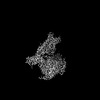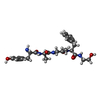+ データを開く
データを開く
- 基本情報
基本情報
| 登録情報 | データベース: PDB / ID: 8k9k | |||||||||||||||
|---|---|---|---|---|---|---|---|---|---|---|---|---|---|---|---|---|
| タイトル | Full agonist-bound mu-type opioid receptor-G protein complex | |||||||||||||||
 要素 要素 |
| |||||||||||||||
 キーワード キーワード | SIGNALING PROTEIN | |||||||||||||||
| 機能・相同性 |  機能・相同性情報 機能・相同性情報Opioid Signalling / beta-endorphin receptor activity / morphine receptor activity / negative regulation of Wnt protein secretion / regulation of cellular response to stress / G protein-coupled opioid receptor signaling pathway / behavioral response to ethanol / adenylate cyclase-inhibiting G protein-coupled acetylcholine receptor signaling pathway / negative regulation of nitric oxide biosynthetic process / sensory perception ...Opioid Signalling / beta-endorphin receptor activity / morphine receptor activity / negative regulation of Wnt protein secretion / regulation of cellular response to stress / G protein-coupled opioid receptor signaling pathway / behavioral response to ethanol / adenylate cyclase-inhibiting G protein-coupled acetylcholine receptor signaling pathway / negative regulation of nitric oxide biosynthetic process / sensory perception / regulation of NMDA receptor activity / neuropeptide binding / GTP metabolic process / positive regulation of neurogenesis / negative regulation of cytosolic calcium ion concentration / positive regulation of macroautophagy / G protein-coupled receptor signaling pathway, coupled to cyclic nucleotide second messenger / G-protein alpha-subunit binding / neuropeptide signaling pathway / voltage-gated calcium channel activity / MECP2 regulates neuronal receptors and channels / sensory perception of pain / Peptide ligand-binding receptors / G protein-coupled receptor activity / electron transport chain / G protein-coupled receptor binding / adenylate cyclase-inhibiting G protein-coupled receptor signaling pathway / adenylate cyclase-modulating G protein-coupled receptor signaling pathway / centriolar satellite / G-protein beta/gamma-subunit complex binding / G beta:gamma signalling through PLC beta / Presynaptic function of Kainate receptors / Thromboxane signalling through TP receptor / G-protein activation / Activation of G protein gated Potassium channels / Inhibition of voltage gated Ca2+ channels via Gbeta/gamma subunits / Prostacyclin signalling through prostacyclin receptor / G beta:gamma signalling through CDC42 / Glucagon signaling in metabolic regulation / G beta:gamma signalling through BTK / ADP signalling through P2Y purinoceptor 12 / Glucagon-type ligand receptors / Adrenaline,noradrenaline inhibits insulin secretion / Vasopressin regulates renal water homeostasis via Aquaporins / GDP binding / Glucagon-like Peptide-1 (GLP1) regulates insulin secretion / G alpha (z) signalling events / ADP signalling through P2Y purinoceptor 1 / cellular response to catecholamine stimulus / ADORA2B mediated anti-inflammatory cytokines production / G beta:gamma signalling through PI3Kgamma / Cooperation of PDCL (PhLP1) and TRiC/CCT in G-protein beta folding / adenylate cyclase-activating dopamine receptor signaling pathway / GPER1 signaling / cellular response to prostaglandin E stimulus / G-protein beta-subunit binding / heterotrimeric G-protein complex / G alpha (12/13) signalling events / Thrombin signalling through proteinase activated receptors (PARs) / Ca2+ pathway / midbody / fibroblast proliferation / High laminar flow shear stress activates signaling by PIEZO1 and PECAM1:CDH5:KDR in endothelial cells / Interleukin-4 and Interleukin-13 signaling / G alpha (i) signalling events / perikaryon / G alpha (s) signalling events / phospholipase C-activating G protein-coupled receptor signaling pathway / G alpha (q) signalling events / periplasmic space / electron transfer activity / neuron projection / Extra-nuclear estrogen signaling / positive regulation of ERK1 and ERK2 cascade / endosome / ciliary basal body / G protein-coupled receptor signaling pathway / iron ion binding / Golgi membrane / axon / negative regulation of cell population proliferation / cell division / GTPase activity / heme binding / synapse / dendrite / endoplasmic reticulum membrane / GTP binding / nucleolus / endoplasmic reticulum / Golgi apparatus / signal transduction / extracellular exosome / nucleoplasm / metal ion binding / membrane / plasma membrane / cytosol / cytoplasm 類似検索 - 分子機能 | |||||||||||||||
| 生物種 |   Homo sapiens (ヒト) Homo sapiens (ヒト) synthetic construct (人工物) | |||||||||||||||
| 手法 | 電子顕微鏡法 / 単粒子再構成法 / クライオ電子顕微鏡法 / 解像度: 2.98 Å | |||||||||||||||
 データ登録者 データ登録者 | Hisano, T. / Uchikubo-Kamo, T. / Shirouzu, M. / Imai, S. / Kaneko, S. / Shimada, I. | |||||||||||||||
| 資金援助 |  日本, 4件 日本, 4件
| |||||||||||||||
 引用 引用 |  ジャーナル: Nat Commun / 年: 2024 ジャーナル: Nat Commun / 年: 2024タイトル: Structural and dynamic insights into the activation of the μ-opioid receptor by an allosteric modulator. 著者: Shun Kaneko / Shunsuke Imai / Tomomi Uchikubo-Kamo / Tamao Hisano / Nobuaki Asao / Mikako Shirouzu / Ichio Shimada /  要旨: G-protein-coupled receptors (GPCRs) play pivotal roles in various physiological processes. These receptors are activated to different extents by diverse orthosteric ligands and allosteric modulators. ...G-protein-coupled receptors (GPCRs) play pivotal roles in various physiological processes. These receptors are activated to different extents by diverse orthosteric ligands and allosteric modulators. However, the mechanisms underlying these variations in signaling activity by allosteric modulators remain largely elusive. Here, we determine the three-dimensional structure of the μ-opioid receptor (MOR), a class A GPCR, in complex with the G protein and an allosteric modulator, BMS-986122, using cryogenic electron microscopy. Our results reveal that BMS-986122 binding induces changes in the map densities corresponding to R167 and Y254, key residues in the structural motifs conserved among class A GPCRs. Nuclear magnetic resonance analyses of MOR in the absence of the G protein reveal that BMS-986122 binding enhances the formation of the interaction between R167 and Y254, thus stabilizing the fully-activated conformation, where the intracellular half of TM6 is outward-shifted to allow for interaction with the G protein. These findings illuminate that allosteric modulators like BMS-986122 can potentiate receptor activation through alterations in the conformational dynamics in the core region of GPCRs. Together, our results demonstrate the regulatory mechanisms of GPCRs, providing insights into the rational development of therapeutics targeting GPCRs. | |||||||||||||||
| 履歴 |
|
- 構造の表示
構造の表示
| 構造ビューア | 分子:  Molmil Molmil Jmol/JSmol Jmol/JSmol |
|---|
- ダウンロードとリンク
ダウンロードとリンク
- ダウンロード
ダウンロード
| PDBx/mmCIF形式 |  8k9k.cif.gz 8k9k.cif.gz | 245 KB | 表示 |  PDBx/mmCIF形式 PDBx/mmCIF形式 |
|---|---|---|---|---|
| PDB形式 |  pdb8k9k.ent.gz pdb8k9k.ent.gz | 186.9 KB | 表示 |  PDB形式 PDB形式 |
| PDBx/mmJSON形式 |  8k9k.json.gz 8k9k.json.gz | ツリー表示 |  PDBx/mmJSON形式 PDBx/mmJSON形式 | |
| その他 |  その他のダウンロード その他のダウンロード |
-検証レポート
| 文書・要旨 |  8k9k_validation.pdf.gz 8k9k_validation.pdf.gz | 1.2 MB | 表示 |  wwPDB検証レポート wwPDB検証レポート |
|---|---|---|---|---|
| 文書・詳細版 |  8k9k_full_validation.pdf.gz 8k9k_full_validation.pdf.gz | 1.2 MB | 表示 | |
| XML形式データ |  8k9k_validation.xml.gz 8k9k_validation.xml.gz | 45.6 KB | 表示 | |
| CIF形式データ |  8k9k_validation.cif.gz 8k9k_validation.cif.gz | 69.1 KB | 表示 | |
| アーカイブディレクトリ |  https://data.pdbj.org/pub/pdb/validation_reports/k9/8k9k https://data.pdbj.org/pub/pdb/validation_reports/k9/8k9k ftp://data.pdbj.org/pub/pdb/validation_reports/k9/8k9k ftp://data.pdbj.org/pub/pdb/validation_reports/k9/8k9k | HTTPS FTP |
-関連構造データ
| 関連構造データ |  36989MC  8k9lC M: このデータのモデリングに利用したマップデータ C: 同じ文献を引用 ( |
|---|---|
| 類似構造データ | 類似検索 - 機能・相同性  F&H 検索 F&H 検索 |
- リンク
リンク
- 集合体
集合体
| 登録構造単位 | 
|
|---|---|
| 1 |
|
- 要素
要素
-タンパク質 , 4種, 4分子 RABG
| #1: タンパク質 | 分子量: 51321.855 Da / 分子数: 1 / 変異: M7W,H102I,R106L / 由来タイプ: 組換発現 由来: (組換発現)   Homo sapiens (ヒト) Homo sapiens (ヒト)遺伝子: cybC, OPRM1, MOR1 発現宿主:  参照: UniProt: P0ABE7, UniProt: P35372 |
|---|---|
| #3: タンパク質 | 分子量: 40585.137 Da / 分子数: 1 / 由来タイプ: 組換発現 / 由来: (組換発現)  発現宿主:  参照: UniProt: F6VL43 |
| #4: タンパク質 | 分子量: 38522.098 Da / 分子数: 1 / 由来タイプ: 組換発現 / 由来: (組換発現)  Homo sapiens (ヒト) Homo sapiens (ヒト)発現宿主:  参照: UniProt: M1ERZ7 |
| #5: タンパク質 | 分子量: 7861.143 Da / 分子数: 1 / 由来タイプ: 組換発現 / 由来: (組換発現)  Homo sapiens (ヒト) / 遺伝子: GNG2 Homo sapiens (ヒト) / 遺伝子: GNG2発現宿主:  参照: UniProt: P59768 |
-タンパク質・ペプチド / 抗体 , 2種, 2分子 SH
| #2: タンパク質・ペプチド | |
|---|---|
| #6: 抗体 | 分子量: 27409.588 Da / 分子数: 1 / 由来タイプ: 組換発現 / 由来: (組換発現) synthetic construct (人工物) 発現宿主:  |
-詳細
| 研究の焦点であるリガンドがあるか | Y |
|---|---|
| Has protein modification | Y |
-実験情報
-実験
| 実験 | 手法: 電子顕微鏡法 |
|---|---|
| EM実験 | 試料の集合状態: PARTICLE / 3次元再構成法: 単粒子再構成法 |
- 試料調製
試料調製
| 構成要素 | 名称: Full agonist-bound mu-type opioid receptor-G protein complex タイプ: COMPLEX / Entity ID: all / 由来: RECOMBINANT |
|---|---|
| 分子量 | 単位: MEGADALTONS / 実験値: NO |
| 由来(天然) | 生物種:  Homo sapiens (ヒト) Homo sapiens (ヒト) |
| 由来(組換発現) | 生物種:  |
| 緩衝液 | pH: 7.5 |
| 試料 | 包埋: NO / シャドウイング: NO / 染色: NO / 凍結: YES |
| 急速凍結 | 装置: FEI VITROBOT MARK IV / 凍結剤: ETHANE / 湿度: 100 % / 凍結前の試料温度: 277 K |
- 電子顕微鏡撮影
電子顕微鏡撮影
| 実験機器 |  モデル: Titan Krios / 画像提供: FEI Company |
|---|---|
| 顕微鏡 | モデル: FEI TITAN KRIOS |
| 電子銃 | 電子線源:  FIELD EMISSION GUN / 加速電圧: 300 kV / 照射モード: FLOOD BEAM FIELD EMISSION GUN / 加速電圧: 300 kV / 照射モード: FLOOD BEAM |
| 電子レンズ | モード: BRIGHT FIELD / 最大 デフォーカス(公称値): 2000 nm / 最小 デフォーカス(公称値): 800 nm |
| 試料ホルダ | 凍結剤: NITROGEN 試料ホルダーモデル: FEI TITAN KRIOS AUTOGRID HOLDER |
| 撮影 | 平均露光時間: 2.3 sec. / 電子線照射量: 50.5 e/Å2 / フィルム・検出器のモデル: GATAN K3 (6k x 4k) |
| 電子光学装置 | エネルギーフィルター名称: GIF Quantum LS / エネルギーフィルタースリット幅: 15 eV |
- 解析
解析
| EMソフトウェア |
| ||||||||||||||||||||||||||||
|---|---|---|---|---|---|---|---|---|---|---|---|---|---|---|---|---|---|---|---|---|---|---|---|---|---|---|---|---|---|
| CTF補正 | タイプ: PHASE FLIPPING AND AMPLITUDE CORRECTION | ||||||||||||||||||||||||||||
| 3次元再構成 | 解像度: 2.98 Å / 解像度の算出法: FSC 0.143 CUT-OFF / 粒子像の数: 308249 / 対称性のタイプ: POINT | ||||||||||||||||||||||||||||
| 原子モデル構築 | プロトコル: RIGID BODY FIT / 空間: REAL | ||||||||||||||||||||||||||||
| 拘束条件 |
|
 ムービー
ムービー コントローラー
コントローラー




 PDBj
PDBj





























